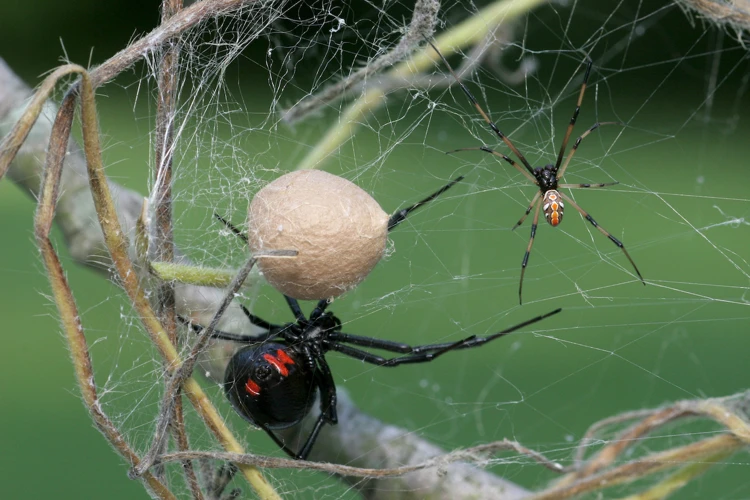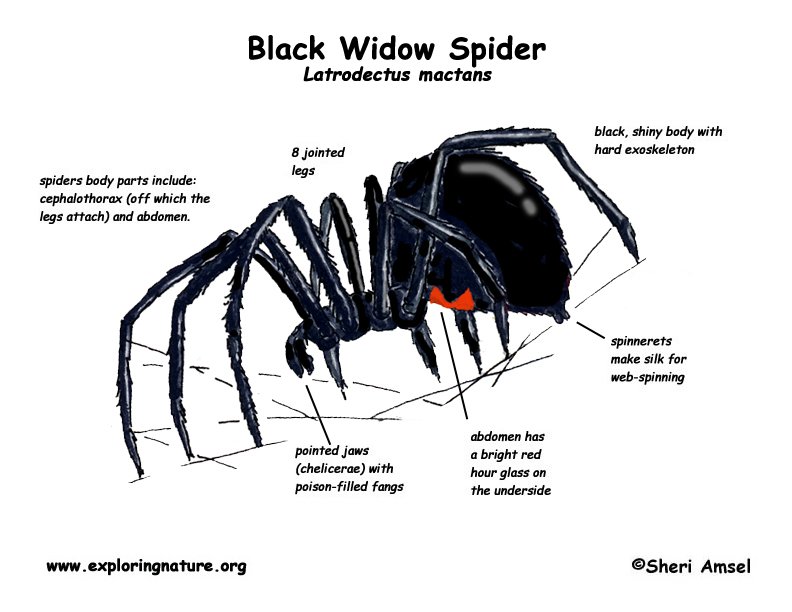Imagine stepping into the world of spiders, where the size of a black widow spider becomes a captivating mystery just waiting to be unraveled. Journey with us as we explore the dimensions of these intriguing creatures, delving into their measurements and uncovering the secrets behind their impressive size. Prepare to be amazed as we delve into the intricate webs of knowledge surrounding the size of a black widow spider.

This image is property of spidersfaq.com.
1. Anatomy of a Black Widow Spider
1.1 Body Size
The black widow spider belongs to the genus Latrodectus, and its body size can vary depending on the species. On average, female black widows measure about 0.5 inches (1.3 cm) in body length, while males are slightly smaller, measuring around 0.25 inches (0.6 cm). However, it is important to note that these measurements are general averages and can vary based on factors such as geographic location and individual variations.
1.2 Leg Span
Along with their body size, the leg span of black widow spiders can also vary. Female black widows typically have a leg span of about 1.5 to 1.7 inches (3.8 to 4.3 cm), while male black widows have a slightly smaller leg span, ranging from 0.75 to 1.25 inches (1.9 to 3.2 cm). The long, slender legs allow black widows to navigate their intricate webs with ease and capture their prey efficiently.
1.3 Abdomen Shape and Size
One characteristic feature of black widows is their distinctive abdomen shape and size. The abdomen of a female black widow is bulbous and round, often shiny black in color, and marked with the iconic red hourglass shape on the underside. The size of the abdomen can range from approximately 0.3 to 0.6 inches (0.8 to 1.5 cm) in diameter, depending on the species and individual specimen.
1.4 Web Dimensions
Black widows are known for their intricate, strong, and sticky webs. The dimensions of these webs can vary, but typically, they are spun within a framework of irregular silk strands. The shape and size of the web can depend on factors such as available space and prey availability. Black widow webs can measure up to several feet in diameter and are often found in dark, sheltered areas such as tree branches, abandoned structures, or outdoor sheds.
2. Female vs. Male Black Widow
2.1 Size Comparison
When comparing female and male black widows, the most noticeable difference lies in their size. As mentioned earlier, females are generally larger than males. This size difference is primarily due to their reproductive roles and the need for females to carry and protect their eggs.
2.2 Sexual Dimorphism
Sexual dimorphism refers to the differences in physical characteristics between males and females of the same species. In the case of black widows, sexual dimorphism is evident not only in their size but also in their appearance. Female black widows possess the distinctive red hourglass marking on their abdomen, which is absent in males. Male black widows, on the other hand, often have lighter coloring and a slimmer build compared to females.

This image is property of spidersfaq.com.
3. Growth and Development
3.1 Egg Size
Black widow spiders undergo a fascinating growth and development process. It starts with the size of their eggs, which can range from approximately 0.08 to 0.1 inches (0.2 to 0.25 cm) in diameter. The exact size of the eggs may vary depending on the species, but they are generally small compared to the spider’s adult size.
3.2 Hatchlings Size
Once the eggs hatch, black widow spiderlings emerge. Spiderlings are tiny compared to their adult counterparts, measuring only about 0.04 to 0.06 inches (0.1 to 0.15 cm) in body length. At this stage, they are vulnerable and rely on their mother for protection and nourishment.
3.3 Adult Size
As black widow spiders grow and molt through several stages, they gradually reach their adult size. The growth rate can vary depending on factors such as food availability and environmental conditions. On average, female black widows can reach a body length of approximately 0.5 inches (1.3 cm), while males tend to be slightly smaller, with a body length of around 0.25 inches (0.6 cm).
4. Geographic Variations
4.1 Size Differences in Different Regions
It is important to note that black widow spiders can display size variations across different geographic regions. For example, black widows found in warmer climates tend to be larger than those in cooler regions. This pattern is likely due to the favorable conditions that promote growth and development in warmer climates.
4.2 Factors Influencing Size Variations
Several factors can influence the size variations observed in black widow spiders across different regions. These factors include temperature, humidity levels, prey availability, and genetic variations within the black widow population. The interplay of these factors contributes to the diverse sizes of black widows seen worldwide.

This image is property of www.exploringnature.org.
5. Factors Affecting Black Widow Size
5.1 Diet and Nutrition
Diet and nutrition play a significant role in determining the size of black widow spiders. Black widows primarily feed on insects, including flies, mosquitoes, beetles, and other small arthropods. A consistent and ample food supply ensures that the spiders receive the necessary nutrients for growth and development. Greater access to food sources can lead to larger individuals within a black widow population.
5.2 Genetics
Genetics also contribute to the size variations observed in black widow spiders. Just like with any living organism, genetic factors influence the developmental processes and eventual size of black widow spiders. Different genetic variations within a species can result in variations in body size, leg span, and other physical characteristics.
5.3 Environmental Factors
Environmental conditions, such as temperature, humidity, and overall climate, can impact the size of black widow spiders. Warmer climates, with longer growing seasons and increased access to resources, have the potential to support larger black widow populations. Conversely, cooler regions with shorter growing seasons may limit the growth and size of black widow spiders.
6. Common Species of Black Widow
6.1 Latrodectus mactans (Southern Black Widow)
The Latrodectus mactans, commonly known as the Southern Black Widow, is one of the most well-known species of black widow spiders. Found primarily in the southeastern United States, these spiders are known for their glossy black bodies and distinctive red hourglass marking on the abdomen. Southern Black Widows tend to be slightly larger compared to other black widow species.
6.2 Latrodectus hesperus (Western Black Widow)
The Latrodectus hesperus, also known as the Western Black Widow, is native to western regions of North America. These spiders display similar physical characteristics to other black widow species, with black bodies and red hourglass markings. The Western Black Widow is slightly smaller in size compared to the Southern Black Widow but is still capable of delivering a potent venom.
6.3 Latrodectus variolus (Northern Black Widow)
The Latrodectus variolus, commonly referred to as the Northern Black Widow, is found in northeastern regions of North America. These spiders are known for their black bodies and red hourglass markings similar to other black widow species. While slightly smaller in size compared to Southern Black Widows, the Northern Black Widow is still considered a venomous species.
6.4 Latrodectus geometricus (Brown Widow)
The Latrodectus geometricus, also known as the Brown Widow, is a species of black widow found in various parts of the world, including the United States. As the name suggests, Brown Widows exhibit a brownish coloration on their bodies, which distinguishes them from other black widow species. They possess smaller hourglass markings and are generally smaller in size compared to their counterparts.

This image is property of spidersfaq.com.
7. Size Comparison with Other Spiders
7.1 Size Comparison with Tarantulas
When comparing black widow spiders to other spider species, it is interesting to note the differences in size. Tarantulas, for example, are known for their large size and can measure several inches in body length. In contrast, black widows are much smaller, with body lengths ranging from 0.25 to 0.5 inches on average.
7.2 Size Comparison with Wolf Spiders
Wolf spiders are another common spider species that can be compared to black widows in terms of size. While some species of wolf spiders can grow quite large, with body lengths exceeding an inch, they generally fall within the same size range as black widows. However, wolf spiders tend to have a bulkier appearance compared to the slender build of black widows.
7.3 Size Comparison with Orb Weavers
Orb weavers are known for their intricate, circular webs and can vary in size depending on the species. Compared to black widows, orb weavers can be larger in body size, with some species reaching lengths of over an inch. However, it is important to note that specific measurements can vary greatly between different species within each group.
7.4 Size Comparison with Jumping Spiders
Jumping spiders are a fascinating group of spiders known for their agility and unique hunting techniques. While they may appear tiny compared to other spider species, some jumping spiders can grow to be similar in size to black widows. However, their overall body structure and behavior differ significantly from black widows, making them easily distinguishable.
8. Size and Venom Potency
8.1 Relationship between Size and Venom Potency
There is a common misconception that the size of a black widow spider directly correlates to the potency of its venom. However, this is not the case. Although female black widows are larger and possess higher venom quantities, the potency of their venom remains relatively consistent between individual spiders. Regardless of size, the venom of a black widow is highly potent and can cause severe symptoms if a bite occurs.
8.2 Venom Quantity and Delivery
The venom of a black widow spider is neurotoxic, meaning it affects the nervous system of its prey. Female black widows, due to their larger size, are capable of injecting a higher quantity of venom with each bite compared to males. This ability to deliver a more substantial venom dose is an evolutionary advantage, aiding in immobilizing and subduing their prey more effectively.

This image is property of a-z-animals.com.
9. Black Widow Size and Human Interaction
9.1 Identifying Black Widows by Size
When it comes to identifying black widow spiders, size can be a helpful characteristic. By understanding the average size range of black widows and familiarizing yourself with the variations that exist among different species, you can better identify them in the wild. However, it is essential to exercise caution and avoid coming into contact with these venomous spiders.
9.2 Implications for Human Safety
Black widows are venomous spiders, and a bite from them can cause significant health risks for humans. Regardless of their size, it is crucial to exercise caution and avoid handling or provoking black widow spiders. If you suspect a black widow infestation or have concerns about their presence, it is best to contact professional pest control services to handle the situation safely and effectively.
10. Myth and Misconceptions
10.1 Giant Black Widow Myths
There is a common myth or misconception surrounding giant black widow spiders. While there have been reports and urban legends about enormous black widows with body lengths measuring several inches, these claims are unfounded. Black widows, as discussed earlier, typically range in size from 0.25 to 0.5 inches, with variations depending on the species and individual specimens.
10.2 Size Exaggerations in Popular Culture
Black widow spiders have often been portrayed in popular culture with exaggerated sizes for dramatic effect. It is important to remember that these portrayals are often for fictional purposes and should not be taken as accurate representations of actual black widow sizes. While the fear and allure of large spiders may capture the imagination, it is essential to rely on scientific information and accurate depictions when learning about these creatures.
